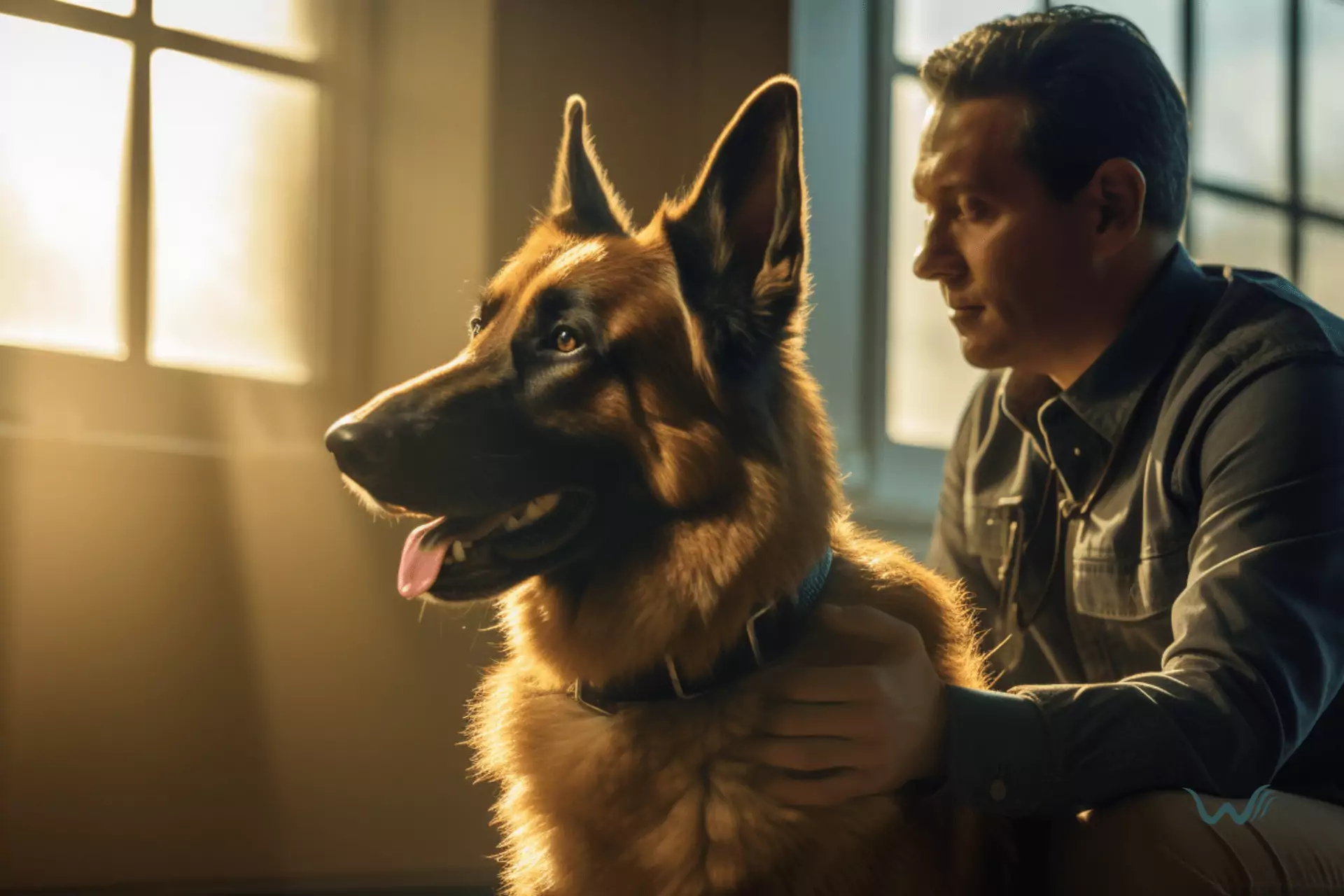

The Importance Of Training A Service Animal
by Tayyaba Amir
Last updated: April 20, 2024
Verified and Approved by:
Angela Morris,
MSW, LCSW
Fact Checked

Are you ready to embark on a journey filled with wagging tails and wet noses? Well, get ready because we’re about to dive into the world of service animals and the importance of training them! You see, these four-legged heroes are not just your average pets. They are highly trained individuals who have the power to enhance the quality of life for their handlers in ways you can’t even imagine.
A service animal is not just your regular old Fido or Fluffy. They are specially trained to perform tasks that assist individuals with disabilities. Whether it’s guiding the visually impaired, alerting those with hearing loss, or providing support for individuals with mobility challenges, these incredible animals are like furry superheroes, ready to save the day. But here’s the catch: they can only become superheroes through proper training.
Key Takeaways
- Service animals are highly trained individuals who assist individuals with disabilities.
- Effective training methods and techniques, such as treat training, clicker training, and target training, are important for the success of service animals.
- Service animals and their handlers have legal rights and protections under the Americans with Disabilities Act (ADA).
- The presence of a trained service animal can have emotional and psychological benefits, bringing joy and comfort to their handlers.
Types of Service Animals
You won’t believe the incredible range of types of service animals available to assist people with disabilities! It’s like a zoo out there, but instead of lions and tigers, you’ve got dogs and horses and even miniature pigs. Who knew these little oinkers could be so helpful? Well, apparently they can be trained to assist people with mobility issues, just like their canine counterparts. And let me tell you, seeing a pig trotting alongside someone in a grocery store is a sight you won’t soon forget.
But it doesn’t stop there, my friend. We’ve got birds in the mix too. Parrots, to be exact. These colorful creatures can be trained to help people with disabilities like hearing loss. Imagine having a feathered friend perched on your shoulder, alerting you to important sounds and making your life just a little bit easier.
So, whether it’s a pig, a parrot, or a trusty old dog, these service animals are truly amazing. They come in all shapes and sizes, but they all have one thing in common – the incredible ability to assist and support those in need. So next time you see a service animal out and about, give them a little extra love and appreciation. They deserve it!
The Role of Service Animals in Enhancing Quality of Life
To enhance the quality of life, service animals play a key role. These incredible creatures have the power to transform the lives of individuals with disabilities, providing them with independence, companionship, and a furry source of joy. Here are three ways in which service animals enhance the quality of life:
- Unconditional Support: Service animals offer unwavering support to their handlers, providing them with emotional comfort and stability. They’re always there to lend a listening ear, or rather, a listening paw, without judgment or criticism. Who needs a therapist when you have a furry friend who can fetch your favorite snack and listen to your problems at the same time?
- Increased Independence: Service animals are trained to perform a variety of tasks that help individuals with disabilities navigate their daily lives with greater independence. They enable individuals to overcome physical limitations and accomplish tasks that would otherwise be challenging or impossible. With a service animal by their side, individuals can confidently go about their day, knowing that they have a trusty companion who has their back, or rather, their leash.
- Social Connection: Service animals have a magical ability to break down social barriers and open doors to human interaction. Their presence often sparks conversations and smiles from strangers who are captivated by their cuteness and impressive skills. Who needs a dating app when you have a service animal that can attract potential suitors with a single wag of their tail?
Service animals are not just furry companions; they’re life-changing partners who enhance the quality of life for individuals with disabilities. Through their unconditional support, increased independence, and ability to foster social connections, these remarkable animals bring joy, companionship, and a whole lot of wagging tails into the lives of their handlers.
Training Methods and Techniques for Service Animals
Effective training methods and techniques greatly contribute to the success of service animals. It is essential to ensure that service animals are well-trained and equipped with the necessary skills to perform their tasks effectively. The training process involves a combination of positive reinforcement, consistency, and patience. By using these methods, service animals can learn to understand and respond to commands, perform specific tasks, and provide assistance to individuals with disabilities.
To grab your attention, let’s take a humorous look at some training techniques with a table:
| Technique | Description | Results |
|---|---|---|
| Treat Training | Rewarding desired behaviors with tasty treats | Happy and motivated service animals |
| Clicker Training | Using a clicker to mark and reinforce good behavior | Highly responsive and eager to please |
| Target Training | Teaching the animal to touch a specific target | Accurate and precise actions |
Now, you might be wondering how these techniques actually work. Well, in treat training, the service animal quickly learns that good behavior leads to delicious rewards. It’s like a job with great benefits! Clicker training, on the other hand, creates a strong association between the sound of the clicker and positive reinforcement. It’s like getting a round of applause every time you do something right! With target training, the service animal learns to touch a specific object, which can be used to guide them in performing complex tasks.
Legal Rights and Protections for Service Animals and Their Handlers
Legal rights and protections are important for service animals and their handlers. When you rely on a service animal to assist you with your daily tasks, it is essential that you have the legal rights and protections necessary to ensure you can access public spaces and receive the accommodations you need.
Without these rights, you might find yourself in a situation where you and your furry companion are denied entry or faced with unnecessary obstacles. And let’s be honest, nobody wants to be the person arguing with a store owner about whether or not your service animal is allowed inside. It’s like trying to convince someone that avocados are a fruit – it’s just not worth the effort.
Thankfully, the law is on your side. The Americans with Disabilities Act (ADA) provides clear guidelines and protections for service animals and their handlers. Under the ADA, service animals are defined as dogs that are individually trained to perform tasks for people with disabilities. And yes, before you ask, miniature horses are also considered service animals. So, if you ever feel like you need a little extra horsepower, you know what to do. These regulations ensure that you and your service animal are allowed access to public places, such as restaurants, stores, and transportation, without discrimination or unnecessary barriers.
How Do You Train a Miniature Horse to Be a Service Animal?
Training miniature horses as service animals involves desensitizing them to different environments, teaching them to respond to verbal and physical cues, and exposing them to various stimuli. Positive reinforcement techniques are used to reinforce desired behaviors. It’s important to consider the horse’s temperament and health when training them for service work.
The Emotional and Psychological Benefits of Service Animals
Experiencing the presence of a trained service animal can significantly improve your emotional and psychological well-being. These furry companions have a magical ability to bring joy and comfort to your life, even in the most challenging of times. Not only do service animals provide emotional support, but they also offer a sense of purpose and responsibility. They rely on you for their care and well-being, giving you a reason to get out of bed each day and face the world head-on.
The emotional and psychological benefits of having a trained service animal by your side are undeniable. They provide comfort, companionship, and a much-needed dose of laughter when life gets tough. So, if you’re feeling down, stressed, or just in need of a pick-me-up, consider the incredible impact a service animal can have on your well-being. Trust me, you won’t regret it.
Frequently Asked Questions
Are there any specific breeds that are more suitable for being trained as service animals?
Sure, let’s talk breeds! Did you know that Labrador Retrievers are the most popular choice for service animals? Their friendly nature and intelligence make them great candidates for training. They’re like the A-list celebrities of the service animal world!
Can service animals be trained to perform multiple tasks or assist with multiple disabilities?
Absolutely! Service animals are incredibly versatile and can be trained to perform multiple tasks or assist with different disabilities. They’re like the Swiss Army knives of the animal kingdom, ready to lend a helping paw whenever needed!
How long does it typically take to train a service animal?
Training a service animal can take anywhere from several months to a couple of years. It depends on the animal’s breed, temperament, and the complexity of the tasks it needs to learn. So, grab some popcorn and get ready for a wild training journey!
Are there any specific certifications or qualifications that a service animal must have?
Yes, there are specific certifications and qualifications for service animals. They must undergo rigorous training to ensure they can perform tasks that mitigate their handler’s disability. It’s like getting a superhero license!
Are there any limitations on where service animals are allowed to accompany their handlers?
Service animals are allowed to accompany their handlers in most public places, including restaurants, stores, and airports. However, there are some limitations, like sterile environments or places where their presence could be a safety concern. But hey, not every place can handle their awesomeness!
Certify Your Emotional Support Animal Today

Why You Can Rely on Us?
At Wellness Wag, we believe your pet deserves care rooted in both science and compassion. Each article is carefully researched, written in clear language for pet owners, and then reviewed by qualified professionals to ensure the information is evidence-based, current, and practical for real-life care. Our goal is to help you feel confident in making informed decisions about your pet’s health and well-being.
Reviewed by
Angela Morris, MSW, LCSW
Angela is a licensed clinical social worker with 20 years of experience in patient advocacy and community mental health. She has assisted numerous clients with ESA evaluations and brings a deep understanding of disability accommodations, ensuring that all information is accurate, supportive, and practical.

Written by :
Tayyaba Amir
Last Updated :
April 20, 2024










